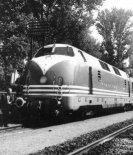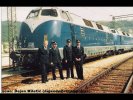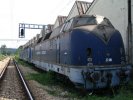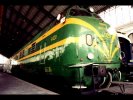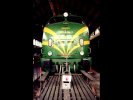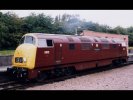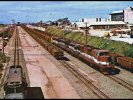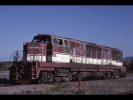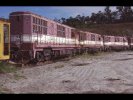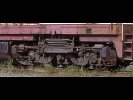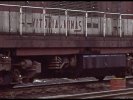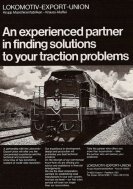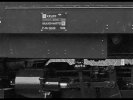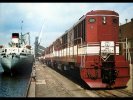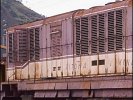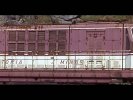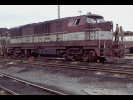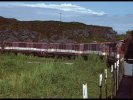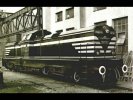|
Southern Pacific
9010
Krauss-Maffei
Cousins
By Robert J. Zenk The Southern
Pacific's Krauss-Maffei locomotives were an evolution of existing
mechanical designs already found in K-M's catalog. What K-M did for the
SP (and Rio Grande) is to add horsepower, use U.S. brake gear and other
running parts, and redesign the frames, trucks, and carbodies/hoods to
better suit U.S.-style operating procedures.
It's
often said by U.S. observers that the K-M's "looked too European". When
taken in context of their evolution, though, it's pretty clear that K-M
went quite far to make them look as "American" as they could.
V200
The V 200 was built
for the German Federal Railways (Deutsche Bundesbahn, or 'DB') and the
rail systems of other European nations as well. Prototypes were built
in 1953-54, and series production began in 1956. Additionally carrying
model designation ML2000, they were 2000 horsepower, four-axle
diesel-hydraulic
locomotives with two Maybach V-12's and two torque converter
transmissions. They achieved great success, and a number of rebuilt
units are still working today. Total production was 86 units, built
also by other manufacturers besides Krauss-Maffei.
They
are considered the iconic German diesel locomotive of the 1950's, and
several are preserved and in regular museum and fantrip operation. (The
resemblance to a Volkswagen Transporter of the same era is not a
complete coincidence!)
V300
The V 300 of 1957
was a higher-horsepower six-axle variant, also carrying model number
ML3000, and created as a demonstrator for K-M. Only one 3000HP unit was
built,
and even this unit did not enjoy particular success, being scrapped by
1980 with no orders for more. It did, however, catch the eyes and ears
of the Southern Pacific
railroad's R&D and mechanical departments, and was the closest
thing to a 'prototype' for the first six U.S. cab units.
It
should be noted that these units -- V 200 and V 300 -- featured
stressed-carbody construction and 'plastic' body panels to meet weight
restrictions on certain rail lines. The SP and Rio Grande 'carbody'
units were really more like American 'cowl' units, having a girder
frame and removable non-load-bearing carbody or hood sections.
ML2200
Carrying
the distinctive stainless steel lettering of the DB V 200s, they were
named 'Dinara', 'Kozara', and 'Sutjeska' after protected natural lands.
They
were powered by twin Maybach MD650 V-12s and had Mekhydro
transmissions.
Following the death of Tito in 1980 they were reassigned to regular
service out of Subotica, operating until 1991. They were returned to
Belgrade (Beograd) in 2005, where they remain awaiting restoration.
These locomotives were the pattern for the higher-horsepower ML3000 (V
300) which caught the attention of the Southern Pacific and led to the
ML4000 series.
RENFE-340 Class
Spain's
RENFE had ten 4000HP Krauss-Maffei locomotives delivered in 1968, with
22 more constructed in Spain under license by Babcock & Wilcox.
Following the pattern of the DB V.200, they put power from
their
twin 2000HP Maybach MD870's to the rails through Mekhydro K184 geared
transmissions. They originally occupied the 4001-4032 number
series, but after "computerization" were changed to 340 001 through 340
032.
Final service was in 1993, and two have been preserved: 340 020 in Madrid and 340 026 at Zaragoza. V160
Early prototype units carried Maybach V-16 model MD870 prime movers similar to SP9010's twin powerplants. Rated at 1,320KW by DIN standards, the first Maybach "loks" were built by Krupp and Henschel, although Krauss-Maffei built a number of V160 locomotives as well. The early V160's served as the pattern for the V-16 "Hymeks" of the UK. Capable of 120 km/h speeds with passenger trains, an unusual operational scheme saw the units placed in the center of certain MU-equipped passenger trains -- an interesting variation on "push-pull". On a colorful note, they were nicknamed "Lollo" after the Italian beauty Gina Lollobrigida (an allusion to the attractive "high cheekbones" of the cab face). One early Maybach-powered version -- V.160 003, pictured above -- is still owned and operated by Deutsche Bahn as part of their heritage fleet. D7000
"Hymek"
One hundred and one units were built for mixed use between 1961 and 1964. Dogged by cylinder head and other problems with their license built prime movers, and by small components not up to the task, they were retired by the mid-1970's. Four have been preserved and fan trip operations continue. D1000
"Western"
Like the Hymeks, they were troublesome at first. Their license-built prime movers caused headaches, even prompting a survey by Maybach into their poor reliability amid reports of abuse and neglect. Like SP's units, they underwent an extensive series of modifications and upgrades which improved reliability, yet they were largely scrapped by the mid-1970's. The “Western” prefix was used because they were all originally ordered for what used to be the Great Western Railway (GWR) before nationalisation, and were used in the South West of the country, the names were contrary to BR Policy – and were a dig at BR. Seventy-four units were built. At recent count, seven are preserved, and several see regular museum and fantrip operation. D800 "Warship"
They were built to a lighter "loading gauge" than their German cousins, weighing in at just 80 tons, and were notoriously cramped in their mechanical spaces. The varying engine and transmission combinations also led to service complications, though reports have the Maybachs outperforming the MAN diesels in reliability, power and length of service between overhauls. Reports from those who worked on them say they were regularly overloaded and abused, could regularly be seen "on fire" and were commonly pushed to speeds in excess of 100mph. As with the SP's Krauss-Maffeis, there were many who shared a vocal lack of fondness for the locomotives. A 'rationalization' plan for diesel locomotive fleet uniformity implemented in 1967 was essentially the death knell for most British diesel-hydraulics, since at the time they numbered scarcely more than 300 units within a nearly 3,000-locomotive fleet. (1967 was not an encouraging year for diesel-hydraulics in Great Britain either, it seems!) Three survivors -- "Onslaught", "Greyhound", and "Glory" -- became just two in 1985, when "Glory" was scrapped due to neglect. Parts were saved, though, and the two remaining locomotives still see excursion and museum operation. Brazil
(Also see "The Boys From Brazil")
Sixteen near-copies of the SP's ML4000C'C' hood units were built between 1966 and 1969 for Brazil's Estrado de Ferro Vitória a Minas railroad. The busy iron ore operation is part of the Companhia Vale do Rio Doce, a huge mining company still thriving today. The Vitória a Minas (EFVM) locomotives were built for meter-gauge track, and showed a number of modifications from the SP design. Built to a tighter loading gauge, the narrower frame clearances and more substantial 'outrigger' suspension for the trucks, cooling systems designed for Equatorial climes, truck-mounted sand boxes and differences in hood sheet metal are the most notable. Fuel tanks were smaller and the SP's rooftop air aftercooler pipes were moved below the frame, also for issues of clearance.
The first batch -- units 701 to 704 -- were built in 1966. Why K-M's? Struggling with long ore drags and increasing traffic, the EFVM was looking to replace multiple diesel lashups with fewer units of higher tractive effort. They were receptive to the same seductive sales pitch delivered to SP and the Rio Grande -- that two K-M's could replace four to five EMD G16 units on the heaviest trains.
Sweetening the deal was a lucrative iron ore export contract with Germany; the four K-M locomotives were a condition of that agreement. (No doubt K-M was looking to recoup some tooling costs from the SP venture.) Krupp was a partner in the ore export contract, and the units were built with the square builder's plate of Krupp/Krauss-Maffei LEU, or Locomotive Export Union. This was a financial arrangement; the units were built on the same production line as their SP predecessors.
Delivered in September of 1966, the K-M's initially made good on their promise. Twelve more -- 705 to 716 -- were ordered in 1967, mirroring the SP's need for a larger fleet of units to properly evaluate the cost-benefit factors and justify the specialized tools and maintenance.
There's no record that EFVM took official regard of SP's difficulties with their K-M's during that same period. And when the second batch arrived in Brazil in 1969, SP's entire fleet of K-M's had already been permanently parked.
There were slight differences in the 1966 and 1969 units, with weight and fuel capacities increasing. There were more louvers on the hoods (called "casa de máquinas" or "machinery houses"), and the doors themselves were split, Dutch-style. One interesting and significant variation from U.S. practice: the brake stands with Wabco 26L valves were to the driver's left and behind, in a large cabinet just forward of the back wall. Operationally, the units earned their keep until a double-tracking project and an economic downturn saw them sidelined for a time. When they were revived, it was soon noticed that their Maybach MD870 engines were experiencing significant wear problems. The miles of hydraulic piping leaked constantly, and crews cursed the slippery walkways that resulted. And wheelslip, supposedly not an issue with hydraulic locomotives, was so bad that one unit sat with wheels grinding away until it had burned itself four inches deep into the railhead! (One wonders if the crew simply let it spin to make a point.) And just like in the States, EMD had extended the reach of its 3600HP SD-45, creating the eight-axle DDM-45 for the EFVM and effectively eliminating the K-M's title to high horsepower and tractive effort. The K-M's were bumped to the middle of locomotive consists, demoted to switching units, even to work trains -- and ultimately sidelined by the late 1970's. Arduous negotiations were begun with Krauss-Maffei to rebuild the units with MTU diesels, successor to the discontinued Maybachs. But costs were higher that the price of new EMD license-built units, and EFVM argued for an extended warranty in compensation. While negotiations dragged on, EFVM rebuilt two units -- 703 and 711 -- in their own shops. In the end, no agreement was reached with K-M and the rest of the fleet was deadlined and cannibalized to keep the two lone rebuilds running.
The 703 and 711 lasted only two more years, victims of their mechanical uniqueness. The EFVM's Krauss Maffei fleet enjoyed a longer run than the SP's, nearly eighteen years in service. But in the end, like the SP units, they were summarily scrapped -- to be mourned only by railfans. A rumor persists that an auto body shop near Vitória retained a 'cabin' (with nose?) -- but this rumor has not been verified.
DH 27.001 -- A Turkish
"What If?"
According to Joe Strapac's fine 1993 book on the SP hydraulics, "Southern Pacific Historic Diesels, Volume 2", some of the first trial specifications supplied to the Southern Pacific by Krauss-Maffei showed the outlines of a unit similar to ones that K-M had recently built for Turkey. These three 1961-built 2700HP C-C units followed the ML3000/V300 mechanical pattern, with Maybach MD655 V-12's and Voith L.630rU transmissions, and featured trucks nearly identical in design to the original SP and D&RGW ML4000 units. They hauled passenger trains, and while inspiring no re-orders, nonetheless saw operation well into the 1980's.
Still, as Joe Strapac suggests -- imagine if this unit had been the one arriving in Houston in 1961, resplendent in fresh red-and-gray, and adorned with a cluster of Gyralites and SP-style numberboards, a full set of handrails, and snowplows on both ends. Whether SP units identical to these would have seemed "too European" to 1961 American railroaders is a question we can't answer. But in retrospect, it does seem that Krauss-Maffei tried very hard to make the U.S. units seem as American as apple pie -- even if what they came up with couldn't hide a hide a hint of apfelküchen! |

